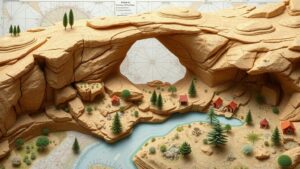Unearthing Hidden Outlaw Loot Along Desert Escape Routes
Unearthing Hidden Outlaw Loot Along Desert Escape Routes
Throughout history, deserts have served as critical escape routes for outlaws and fugitives seeking to evade law enforcement. The arid landscapes, with their harsh terrains and limited visibility, provided ideal settings for hiding ill-gotten gains. This article delves into the historical context, techniques for discovering hidden treasures, and the modern implications of outlaw loot recovery along these treacherous paths.
Historical Context: The Role of Deserts in Outlaw Lore
Deserts have played a pivotal role in the narratives surrounding outlaws, especially during the American Wild West era. expansive and unforgiving nature of desert terrains, such as the Mojave Desert or the Sonoran Desert, offered perfect cover for those engaged in criminal activities. There are numerous documented cases of outlaws, such as Butch Cassidy and the Sundance Kid, who utilized these routes for their daring escapades.
One historical example is the notorious Gold Rush era when many miners hid their illegally acquired wealth while fleeing westward. The deserts isolation allowed these individuals to stash caches of gold and valuables with the hopes of reclaiming them later. Research indicates that during the 1849-1850 Gold Rush alone, thousands of prospectors ventured across these arid landscapes, often leaving behind treasures that remain undiscovered.
Techniques for Discovering Hidden Loot
The recovery of outlaw loot requires a combination of historical research, physical exploration, and modern technology. Here are several successful methods:
- Historical Analysis: Studying historical documents, maps, and journals can reveal significant clues about where outlaws may have concealed their treasures. Local museums and libraries often contain archives of regional history.
- Metal Detecting: The use of metal detectors has proven effective in locating buried metals, including coins, jewelry, and artifacts left behind by fleeing criminals. Enthusiasts have reported finding items ranging from vintage coins to priceless relics.
- Ground Penetrating Radar (GPR): This technology allows researchers to look beneath the surface of the earth, potentially unveiling hidden treasures without the need for extensive excavation. GPR has been employed in archaeological sites and can be adapted for recovery efforts along desert escape routes.
- Community Collaboration: Engaging local historians and treasure hunting groups can vastly improve the chances of successful recoveries. Collaborations often lead to shared knowledge that can point explorers in the right direction.
Real-World Applications: Successful Discoveries
The pursuit of hidden treasures is not just an exercise in historical curiosity; it often yields tangible results. Numerous successful treasure hunts have revealed significant finds:
- The Lost Dutchman Mine: Located in the Superstition Mountains of Arizona, this legendary gold mine has captivated explorers for over a century. Though its exact location remains debated, many treasure seekers have stumbled upon gold artifacts that were hidden by outlaws in the area.
- Cache of the Lindbergh Kidnapping: Following the infamous kidnapping of Charles Lindbergh’s son in 1932, a significant cache of cash was buried in the desert by the kidnappers to hide their illicit gains. Although many efforts have been made to recover the remaining cash, only a fraction has been located.
Challenges and Ethical Considerations
While the thrill of treasure hunting can be exhilarating, several challenges arise during such undertakings. harsh environments of deserts can pose physical dangers, including exposure, dehydration, and rugged terrain. Also, legal challenges may also arise, as many locations may be protected under federal or state regulations.
Also, ethical considerations should not be overlooked. It is crucial to respect the heritage and cultural significance of the land. Treasure hunters should seek appropriate permits and avoid disturbing archaeological sites of historical importance. Engaging with local indigenous communities for insights on the lands history can also foster a respectful treasure-seeking approach.
Actionable Takeaways
For those interested in embarking on their mission to unearth hidden outlaw loot, follow these actionable steps:
- Conduct thorough research on the historical context of your chosen desert area.
- Invest in appropriate technology, such as metal detectors or GPR systems, to increase your chances of success.
- Connect with local historical societies for guidance and share findings with the community.
- Prioritize safety by preparing adequately for harsh desert conditions and carrying essential supplies.
- Always respect the law and the cultural significance of the land you are exploring.
By peeling back the layers of history intertwined in the desert’s sands, treasure hunters may not only uncover priceless artifacts but also reignite tales of adventure and resilience that define the outlaw spirit.



